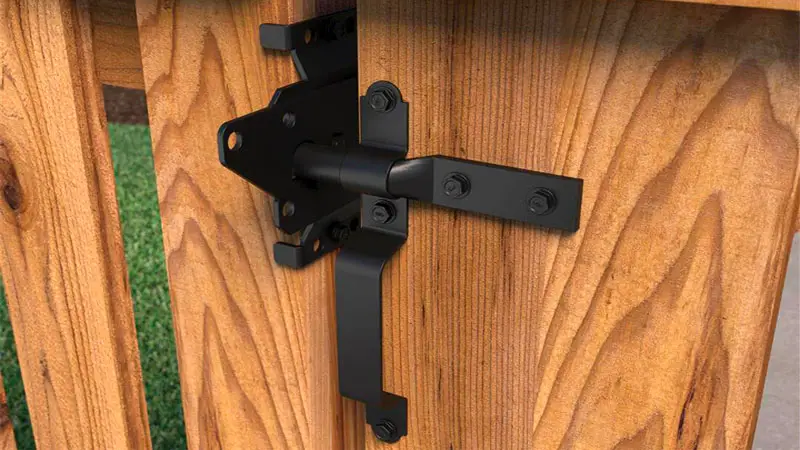Updated on January 3, 2022
There are many different types of gate latches to choose from, so knowing which one to choose can be a difficult task. For that reason, we’ve created this guide to help you purchase the perfect latch(es) for your project.
Gate latches can be broken up into two classes: gate latch categories and actual types. Gate latch categories refer to the design of the latching mechanism, while gate latch types refer to the materials used and style of the locking mechanism. Let’s take a look at both classes.
Gate Latch Categories
“Gate latch category” refers to the design of the latch. In other words, the category of a gate latch depends on the mechanism that makes the gate latch. In total, there are three categories of gate latches.
Gravity
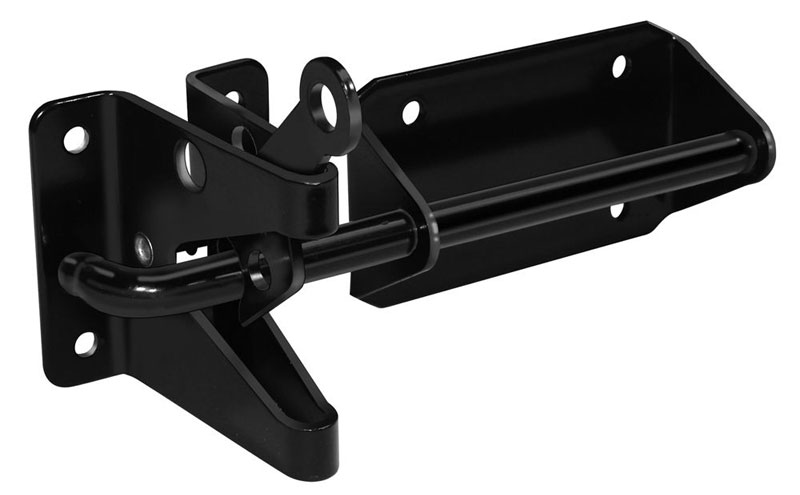
The first gate latch category is gravity gate latches. As the name suggests, gravity gate latches depend on gravity to close the catch. This means that gravity forces the latch down into the barricading strike plate. Once the latch falls into the strike plate, the gate is closed and locked.
Since the latch must fall into the strike plate for the lock, these models are always two-sided. This means that you will be able to open the latch from either side of the barricade in most cases. In most designs, there is a hole for the padlock.
When most gravity gate latches are installed, the latch is typically installed on the inside of the door, but you can install it on the outside if you would like. In either case, gravity locks can be opened from either side of the door.
Most people opt for a gravity latch if they want to keep pets or children inside the fenced area. Gravity locks do not provide much protection from adult intruders since they require no key or pin number and can be opened from either side of the fence.
The biggest benefit of a gravity gate lodge is that they are self-latching. This means that whenever you close the gate or the wind blows it shut, the latch should lock on its own. You will not need to lock it yourself.
This fact makes the gravity gate latch very simple to use. This is great if you have children because they will be able to lock the gate as well. The only thing you have to do is close it all the way shut.
Another benefit of gravity gate latches is that they are extremely easy to install. Even those with minimal tools and experience should be able to install this kind of latch.
The obvious downside of this gate latch is that it does not prevent intruders from coming inside the fenced area.
Spring Loaded
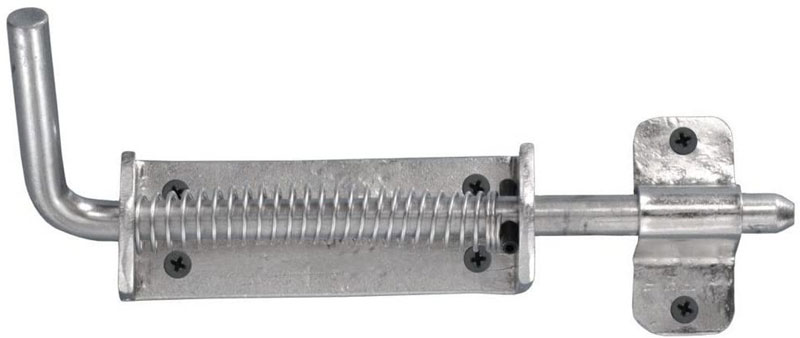
Spring loaded latches are another popular gate latch category. Spring loaded latches differ from gravity latches in that the latching mechanism is motivated by springs. This spring makes a smoother closing action and causes these latches to be more expensive.
How spring loaded latch is work is that the latch arm snaps into place due to the spring’s pressure. This pressure comes from you.
Like the gravity gate latch, spring loaded latches are also two-sided. This two-sided design will allow you to open the gate from either side of the door. Unlike the gravity gate latch, though, this latch can come with lockable options. This act will make this model more protective than the previous one.
Typically, spring loaded latches are used on in-swinging doors, but you can perform a reverse installation to place it on out-swinging gates instead.
One reason you may want a spring loaded latch is that they are easy to use and install, much like the gravity latch. This means that most anyone, except for small children and pets, will be able to install or open this gate latch.
At the same time, though, these gates are more protective than gravity latches since they can come with latching features. For this reason, you may opt for this category of gate latches.
The main downside of spring loaded gate latches is that they are less protective than bolt latches, which we will discuss next. More so, these latches can be the most difficult to install of the three categories.
Slide Bolt
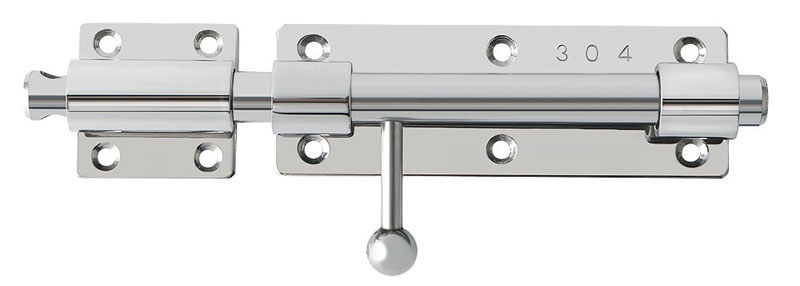
Slide bolt gate latches are the most common for securing your fence. It has a traditional deadbolt design that works by sliding the rod into a securing bolt. That bolt then holds the door in place.
Bolt gate latches are one-sided and can be secured from the inside. You will even have the option to add a bolt gate to both an in-swinging and out-out-swinging fence door, which makes these latches more functional than the others.
The most beneficial aspect of this bolt gate latch is that it is highly functional. It will keep the door in place in almost any scenario. The only way for the rod to be moved is if a person lifts the rod and slides it to the other side of the latch.
Another benefit of bolt gate latches is that they are much more protective than the other two options. Almost all options come with a lockable feature and you can even add a padlock for additional protection. These features make bolt gate latches the most protective of the three categories.
Additionally, bolt gate latches are the least expensive and come in many options. So, this latch category is probably best if you are on a tight budget.
The main downside of this gate latch category is that it can be more difficult to open these fence doors since the latch is one-sided. Of course, this is ideal for protective purposes, but it can get annoying if you are the property owner trying to get into the fenced area.
Gate Latch Types
Within the three categories above are various gate latch types. These types differ based on style and materials used. In other words, choosing the type of gate latch you want depends on aesthetic preferences more than anything.
1. Thumb
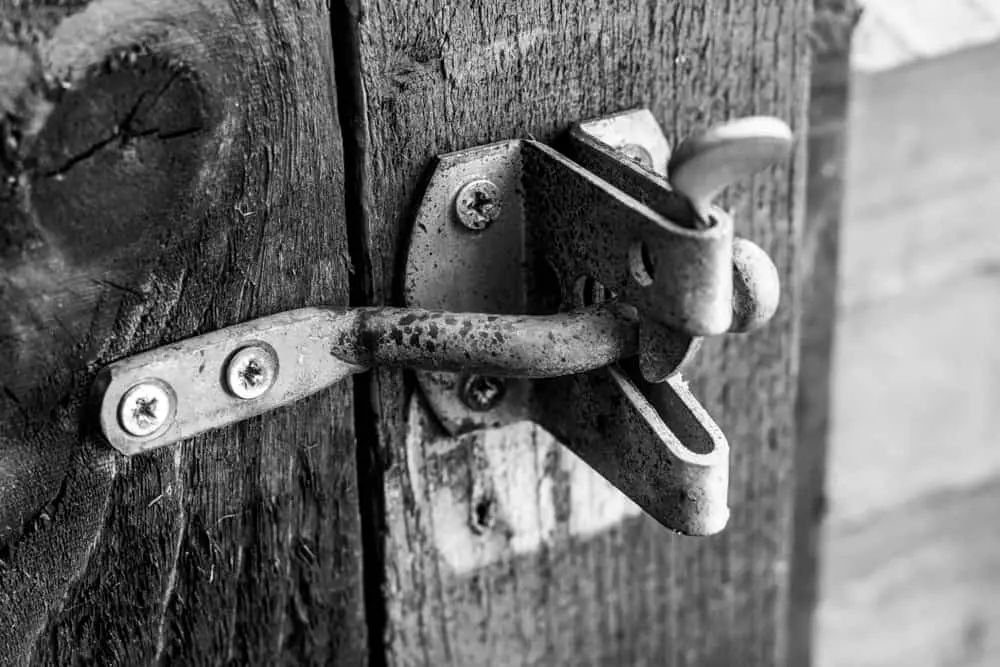
One popular gate latch type is the thumb gate latch. This model works because of a thumb depressor and the latch. When you push down on the thumb depressor, the latch lifts and allows you to open the gate. When the thumb depressor is not activated, the latch falls and locks the gate.
Most thumb gate latches have a gravity latch. This is because gravity forces the latch to fall whenever the pressure from the thumb depressor is released.
The thumb gate latch type only applies if you have an in-swinging gate. Additionally, it is always installed as a double-sided mechanism. Since it comes double-sided, you can also have a lock for added security.
The main benefit of the thumb gate latches that it is extremely easy to use. Simply put your thumb on the depressor and pull the door to open. To close, simply push the door shut without activating the thumb depressor.
Another benefit of this gate latch type is that it is very picturesque to look at. It is very simple and elegant, making it a great choice if you are most concerned about the appearance of your fence and gate latch.
2. Ring
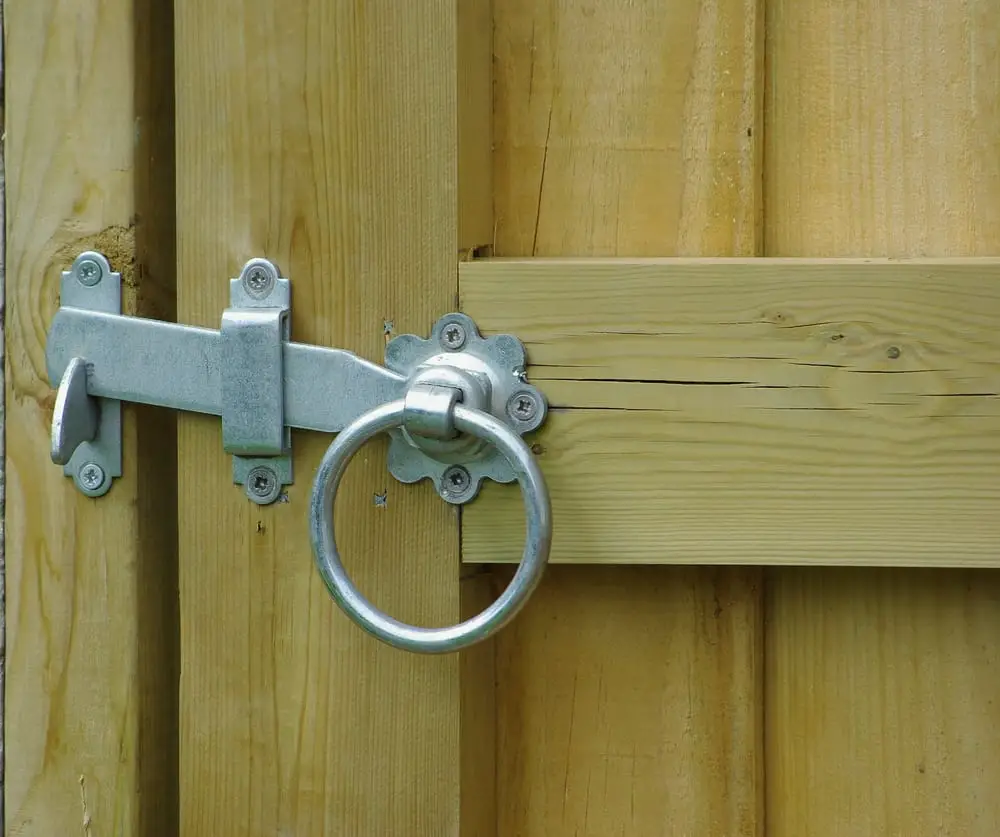
A ring gate latch is another gate latch type. This ring option has a two-sided design that you will be able to operate from both sides of the fence. On the outside, you can put a backplate with a ring on it, while the inside has a backplate and ring that is attached to the latch arm.
To open the door, all you will need to do is turn the ring. Once the ring is turned, the arm is lifted out of the catch, allowing the door to swing open. You will be able to open the door from either side of the fence.
How the door latches depend on the gate latch category. Ring gate latches can either have gravity or spring loaded lock activations. You can learn about how specific models lock based on their category.
The benefit of a ring gate latch type is that they can be opened from the inside and outside. This will be great if you are not as concerned about protective features and want access to your gate from both sides of the fence.
Obviously, the downside of this fence is that it is not very protective. If you are most concerned about keeping intruders out of the fenced area, this gate latch type is not ideal for you.
3. Lever
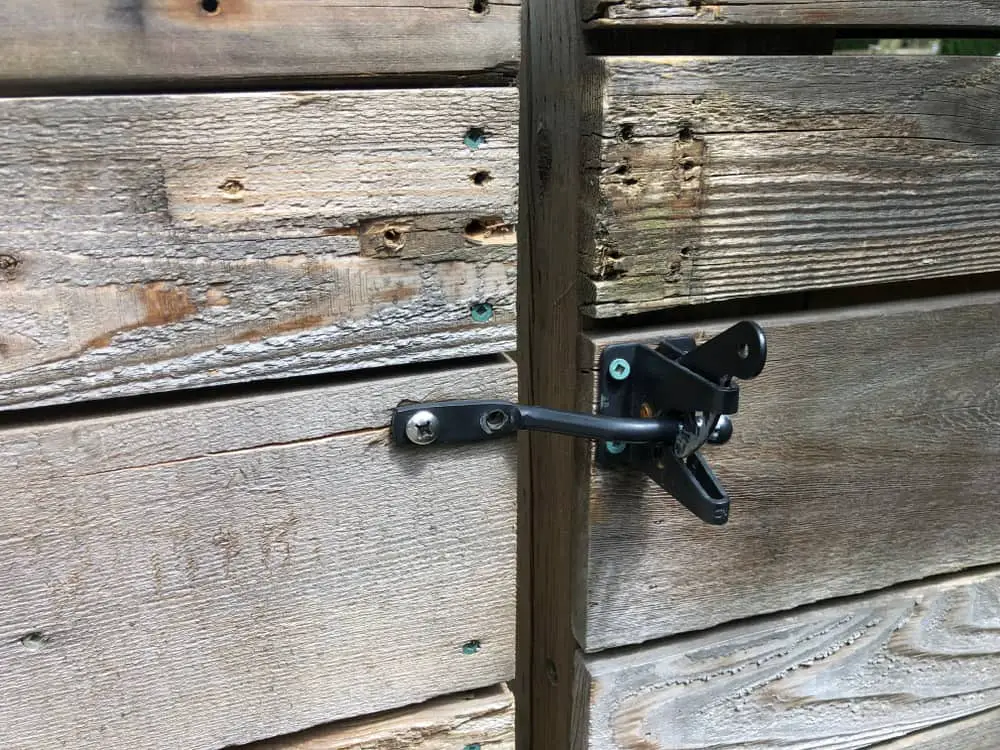
The lever gate latch type is extremely similar to the ring type. In fact, the designs operate almost the same. The only difference is that this lever option has a lever handle instead of a ring on both sides of the fence.
To open the door, all you will need to do is open the lever. Once the lever is opened, you are free to open the door. Closing the door, though, is less straight forward since it depends on whether it belongs to the gravity category or spring loaded category. Most options are gravity latches.
One benefit of lever gate latches is that they are easy for adults to use but difficult for children. This fact is beneficial because it ensures that children and pets will not be able to escape the fenced area easily. At the same time, no adults will struggle with using the lever.
Another benefit of the lever gate latch type is that it can be installed on in- and out-swinging gates. This means that you will be able to access the lever from both sides of the fence.
Of course, this feature makes this gate latch category less protective than others, which is a negative of it. However, you can buy lockable lever options to resolve this issue.
4. Bolt
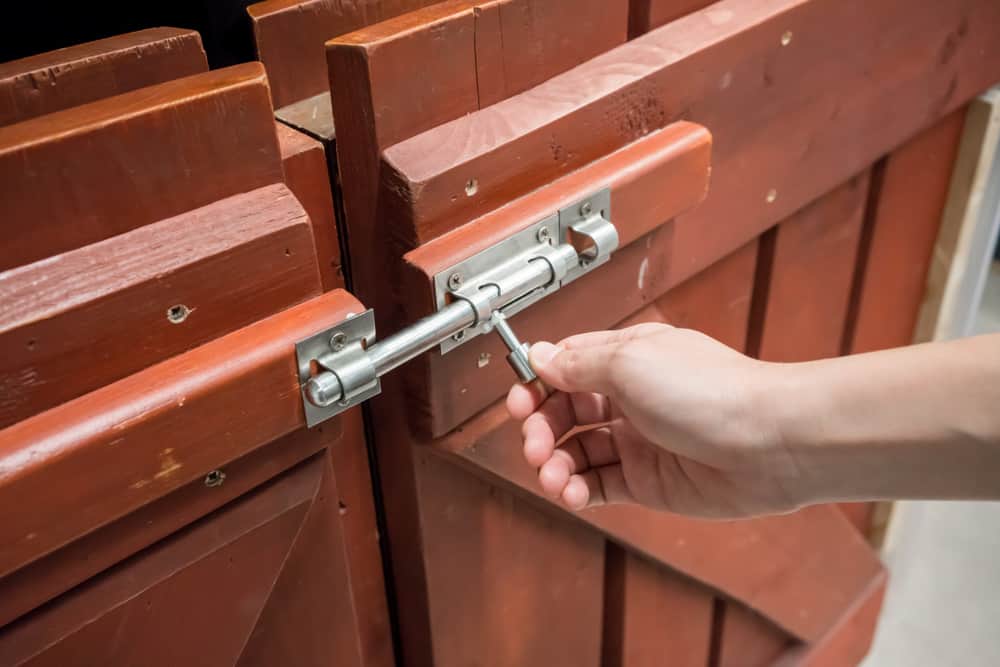
Bolt gate types work exactly as you would imagine. They are one-way only and keep the gate shut by activating the bolt. You will only be able to activate the bolt from one side unless it is in a place where you can reach over the fence and unbolt it from there.
This gate latch type is ideal because it is far more protective than the other options. Since it is one-sided, people will not be able to easily open the gate from the outside. More so, bolt gate latches often come with lockable features and places for additional padlocks, making it even more protective.
The biggest downside of the bolt gate latch type is that it may be difficult to get back in if you get locked out on accident. You will either have to reach of the fence, hop over the fence, or call someone to unlock the fence for you.
Gate Latch Materials
There are several different materials to choose from when buying a gate latch. While any of them will work as proper gate latches, some have more pros than others. Additionally, the cost will vary between the different materials.
5. Iron
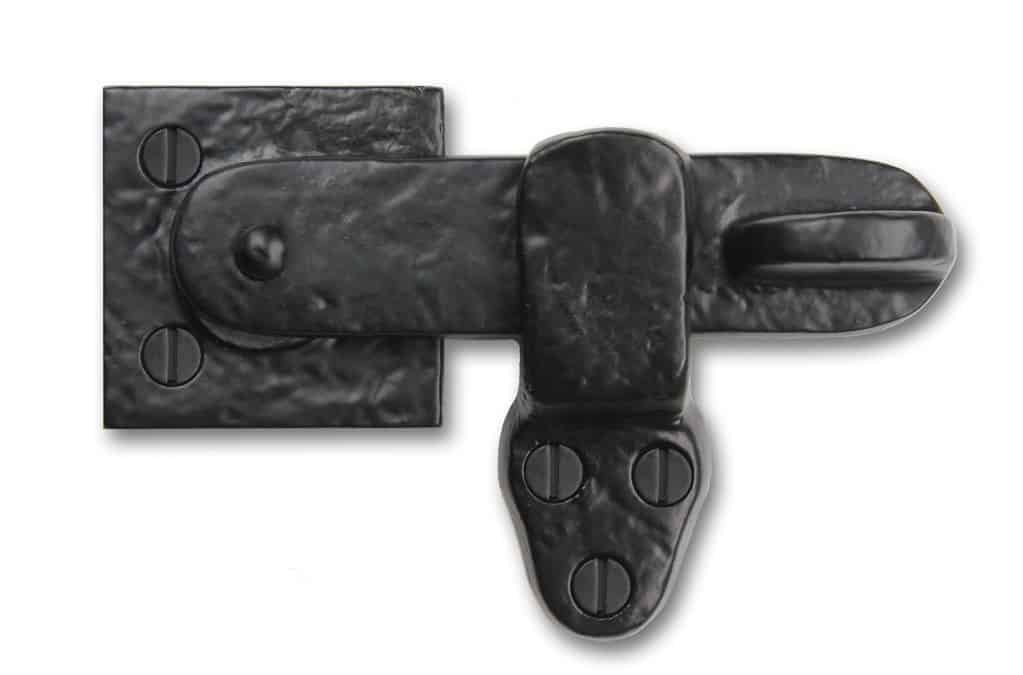
Image Source: Iron Valley Hardware
Iron is one of the most widely used materials for gate latches. It has been used all the way from the Old World period to today. The reason that it has been used for so long is that it is strong, heavy, and attractive-looking.
Gate latches made from iron come with a powder coating. This coating protects the latch from elemental corrosion and rust. Because of this, your iron gate latch should last many years, but you will need to clean it with a steel wool semi-regularly. You also might want to spray it with protectant.
The main downside of this material is that it will not be as long-lasting in corrosive environments like the beach. If you live in an area like this, it is recommended to try a different material.
Cost: $20-$100, depending on size, design, and additional features
6. Aluminum
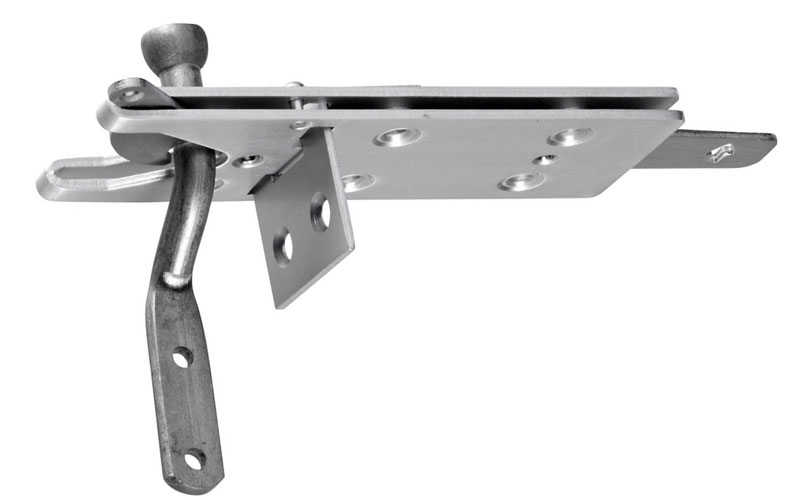
Image Source: HardwareandTools.com
Aluminum is another great material option. It is much more resistant to wear and tear than iron and is both light-weight and durable. Aluminum itself is silver, but you can get aluminum gate latches covered in different-colored powder.
The biggest benefit of aluminum is that it is naturally-resistant to corrosive elements. As a result, you will be able to use an aluminum gate latch anywhere.
Another benefit of aluminum gate latches is that they are extremely inexpensive. In fact, these gate latches tend to be the least expensive of the five materials.
One downside of aluminum gate latches is that the painted latches can chip. When this happens, you will have to repaint your latch. Repainting the latch is not difficult, but it can be annoying.
Cost: $5-$20, depending on size, design, and additional features
7. Bronze
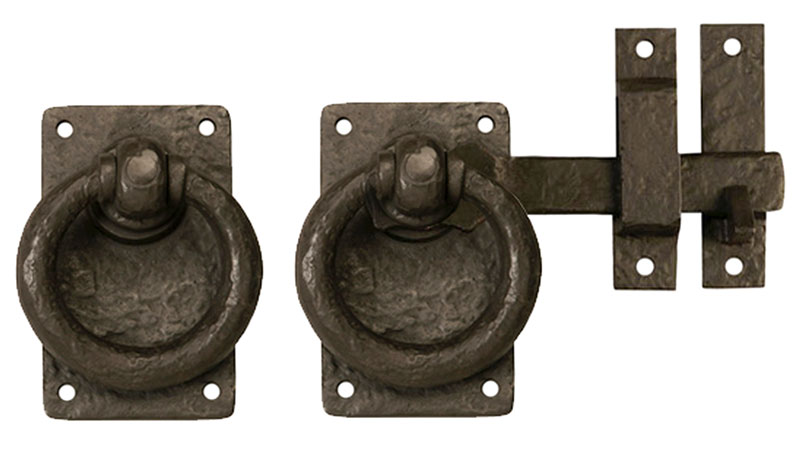
If you are most concerned about the aesthetic qualities of your fence, you may want to invest in a bronze gate latch. Bronze gate latches will age beautifully and cost a pretty penny.
One reason you may want a bronze gate latch is that they are typically very ornate and beautiful. Most bronze latches are designed artistically with high-end designs in mind. For this reason, bronze gate latches can be some of the most beautiful.
Another benefit of bronze gate latches is that bronze ages beautifully. It does not require a powder coating and ages naturally. It darkens over time, causing it to transform from a dark copper color to a faded green color. You can avoid the green coloration by applying a wax coating once a year, though.
You may not want a bronze latch, however, because of how expensive it is. It is easily one of the most expensive options on this list, causing it to be a high-end option. It is usually not suitable for tight budgets, but it does not hurt to look.
Cost: $75-$500, depending on size, design, and additional features
8. Stainless Steel
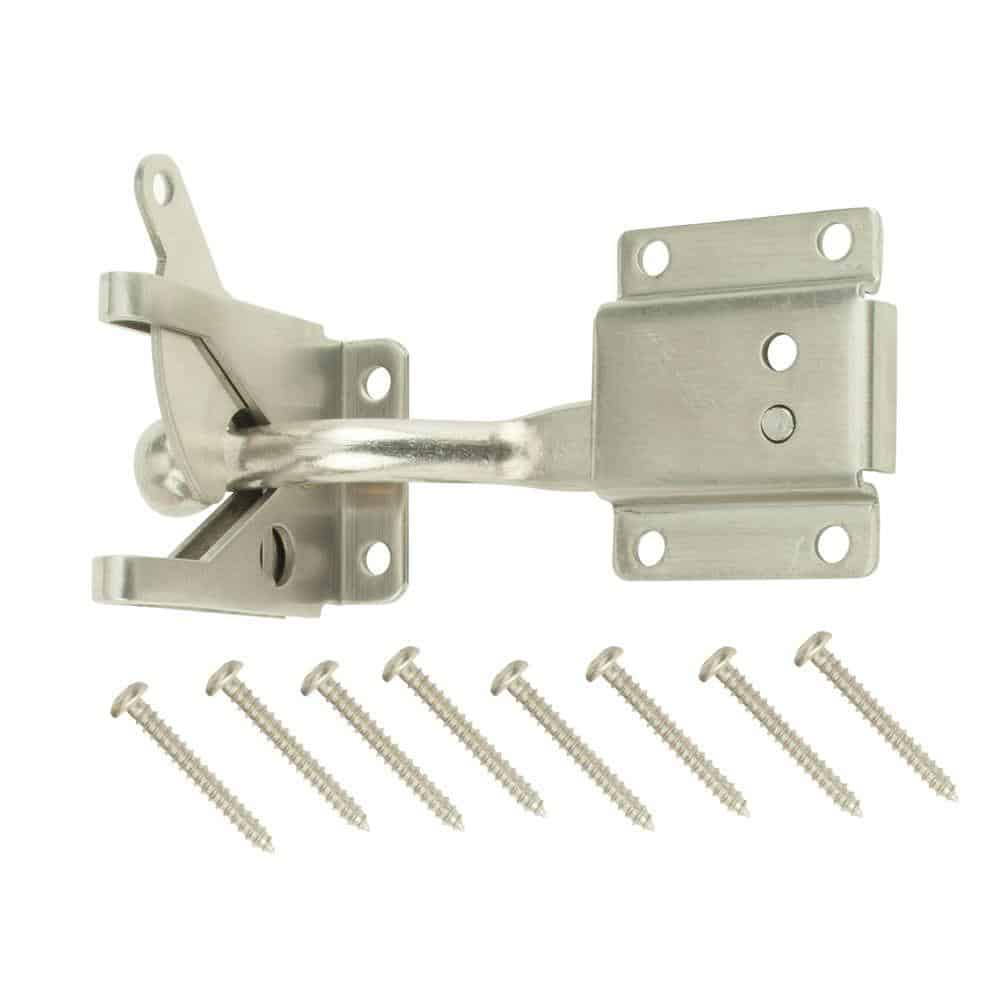
Image Source: Home Depot
Stainless steel is another great option for gate latch material. It is very similar to aluminum, but it is heavier, stronger, and less likely to be damaged under pressure or temperature.
As a result, one great benefit of stainless steel latches is that they are incredibly strong. It is not likely that you will need to maintain or buy a new stainless steel latch within a short period of time. Instead, stainless steel latches should last a long time.
Additionally, you can find a lot of stainless steel options in a variety of colors. The reason for this is that you can get stainless steel latches that have been covered in powdered coats. These powdered coats will add even more protection and change the color of the material.
The main downside of stainless steel is that it is slightly more expensive. If you were on a tighter budget, it is recommended to choose an aluminum gate latch instead of a stainless steel one.
Cost: $30-$75, depending on size, design, and additional features
9. Brass
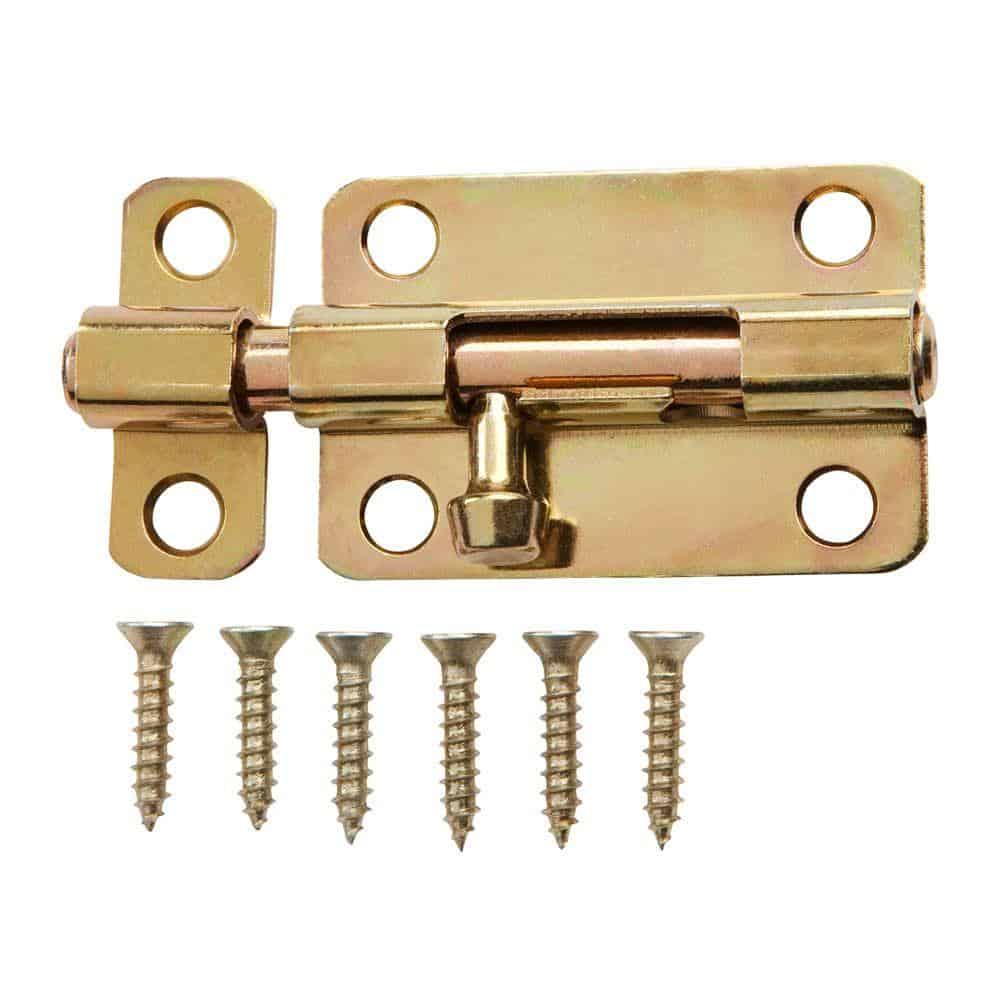
Image Source: Home Depot
A less common gate latch material is brass. You might want brass if you like a traditional or colonial look or like the heavy metal feel of brass.
The main reason someone would choose brass over any of the other materials is that they are specifically going for a colonial style. Brass immediately makes the lodge look much more traditional and dated. As a result, this will be your choice if you want a traditional looking gate latch.
Many people opt for other materials over brass, though, because they tarnish over time. You will have to regularly clean the brass and apply UV resistant coating to the metal just to keep the lock in working order. If you do not want to put in this extra work, you should consider a different material.
Cost: $20-$50, depending on size, design, and additional features
Things to Consider When Selecting a Gate Latch
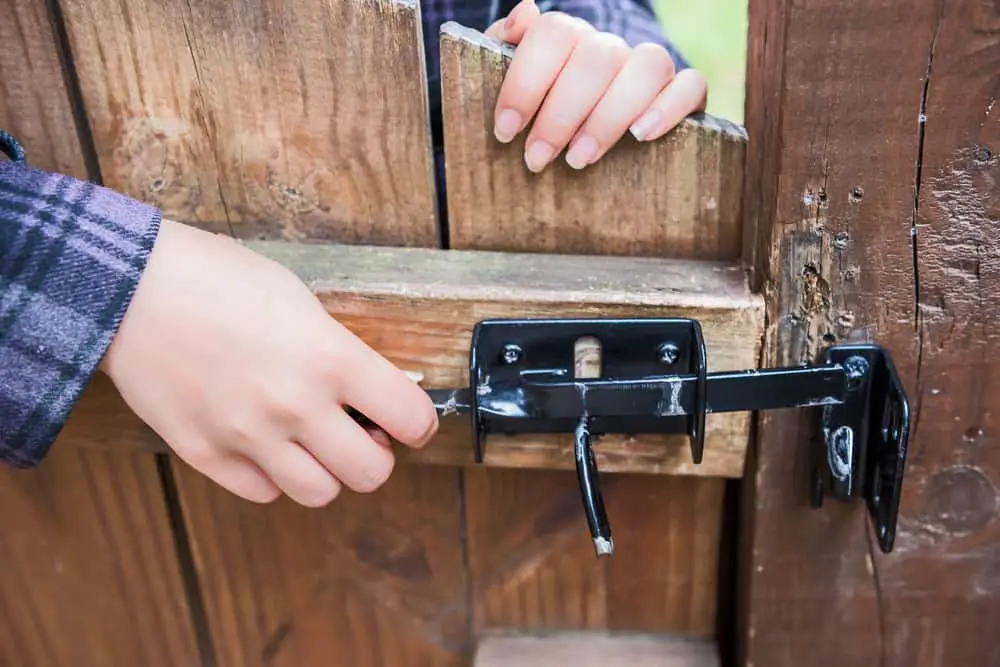
Now that you know the different gate latch categories, types, and materials, you may want to start considering what gate latch is best for you. Here is a list of things to consider when selecting your own fence gate latch.
Security
The most important factor to consider when buying a gate latch is how much security you want your latch to provide. As we saw earlier, certain categories and types provide more protection than others. So, how much security and protection you want should be the first question you ask yourself.
If security is your main reason for wanting a gate latch, you should definitely get a bolt gate latch. This category/type is much more protective than the others. If you do not like the bolt style, though, you can select a different gate latch type, but make sure it comes with lockable features.
For some, security may not be as big of an issue. Perhaps, you just want to make sure your dog will stay in the fenced location. If this is the case, then you can go with virtually any gate latch category and type.
Door Material
When you are installing any kind of outdoor apparatus, you have to consider elemental and weather factors. In the case of gate latches, you have to use door hardware that is designed for seasonal wood movement.
In short, wood moves throughout the year. During the dry months, the wood will be much more shrunken than it would be in the winter or wet months. During the wet months, though, the wood will swell, causing the latch to not catch properly.
In order to account for this movement, you need to use the proper tools and equipment for outdoor use. To make sure you are doing the right thing, consult manufacturer specifications on how to account for seasonal movement. This will cause your gate to latch properly during all months of the year.
Gate Type and Features
Another thing to consider when you are deciding on a gate latch is the type of gate door you have. You can get a single gate, double gate, or sliding gate. You will need to make some design decisions regarding the type of gate you have.
For example, if you have a gate with a very large opening, you will want a gate latch that is chunkier. The reason for this is that it needs to stand out against the door. Similarly, if you have a double door, you will want to have a handle on the fixed side in order to make the fence look more symmetrical.
You may also want to install additional features to your gate door in order to preserve the life of your gate latch. For example, you may want to install gate stops. Gate stops will prevent double and sliding doors from banging together and hurting the metal or material of the gate latch.
How gate stops work is that they create a boundary that the door cannot move beyond. This feature will be extremely helpful if you have children who like to slam the door or if you live in a very windy area.
If you are concerned about your budget, gate stops should not be that big of a worry. You should be able to find a good gate stop for under $20. More so, gate stops ensure the longevity of your gate latch, which will save you money in the long run.
Installation
When you are installing your gate latch, it is important to consult the instructions attached to your gate latch. Each gate latch may have slightly different instructions, and so it is important to consult the manual even if you have experience.
Before beginning the installation process, read through the manual, and make sure you have the needed tools. Once you have that in order, you can begin installing the lock. As you are working, make sure to measure accurately so as to get the best results.
Conclusion
There are a good variety of gate latch types to choose from. First, you will have the choice between three categories: gravity, spring loaded, and slide bolt. Then, you will have the choice between four gate latch types: thumb, ring, lever, and bolt. And finally, the choice between five materials: iron, aluminum, bronze, stainless steel, and brass.
Before picking out your gate latch, though, you will need to consider a few things such as the intended security, door materials, and gate type and features.
Once you have picked out your gate latch, make sure you read the instructions and have the tools you need. After you have done that, you are free to start working!

